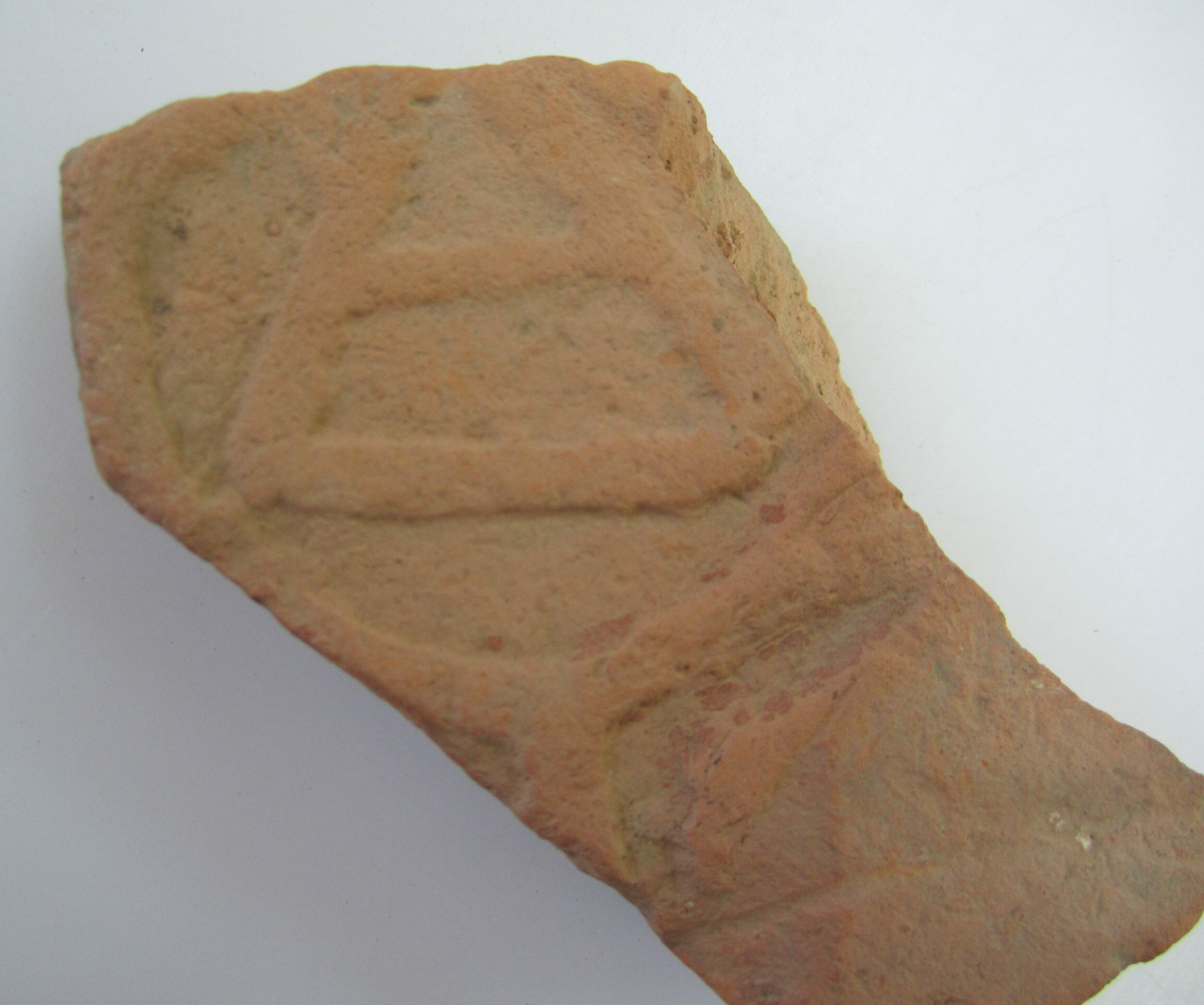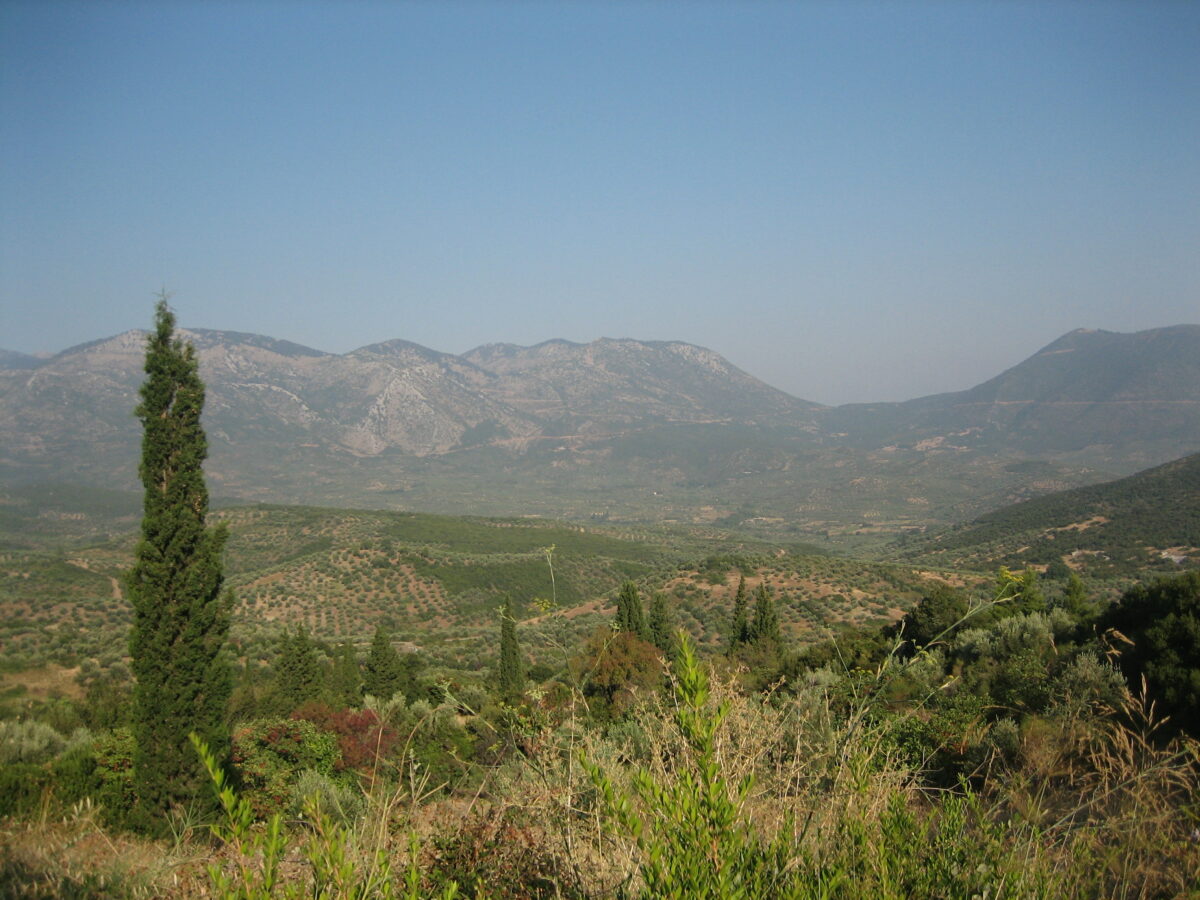The Boeotia Regional Survey Project
INTRODUCTION
Note: most of the Boeotia publications discussed below can be read and downloaded from John Bintliff’s online website, using the following details:
You can reach the site at: http://www.mmvi.nl/jb/
The required credentials to access the publication database are:
Username [Gebruikersnaam]: visitor
Password [Wachtwoord]: publications
Location map of ancient towns and landscapes surveyed by the Boeotia Project from 1978 to the present (by Emeri Farinetti):
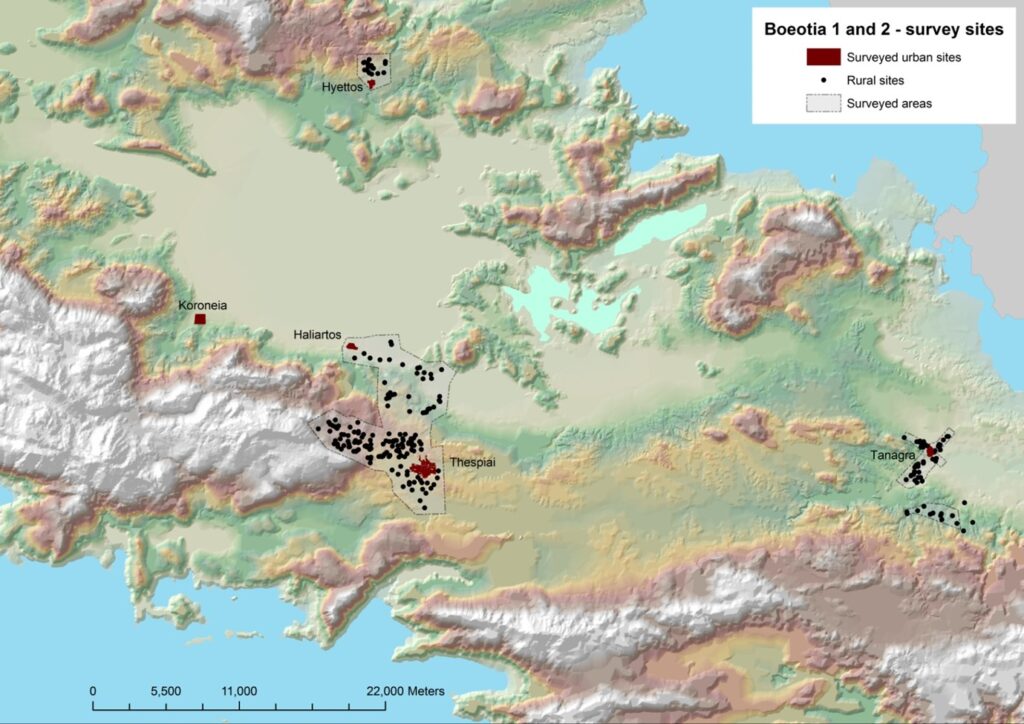
Boeotia is a large region in Central Greece, anciently some 2540 sq km, within which around 15 city-states existed in Antiquity. The region’s landscape archaeology and history had been rather neglected by 20th century scholarship, with several important exceptions. John Fossey’s doctoral thesis had gathered together all recorded sites from Prehistory to Late Antiquity in a useful gazetteer and he made a preliminary analysis of site numbers by period (Fossey, J. M. 1988). He had also conducted excavation and survey at the smallest ancient Boeotia city, Khostia (Fossey 1986). The Byzantine Atlas Project of the Austrian Academy of Sciences had opened its monograph series on each Byzantine province (theme) with a volume dedicated to Hellas and Thessalia, which included Boeotia (Koder, J. and F. Hild (1976) (see its map below).
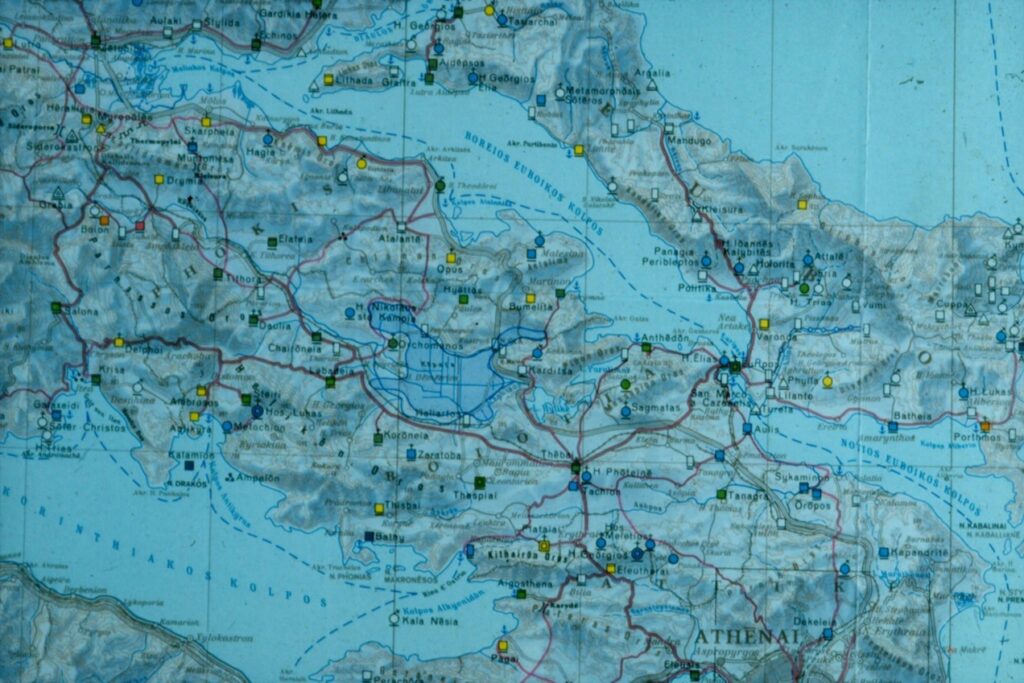
Fossey, J. M., Ed. (1986). Khostia. Results of Canadian Explorations and Excavations at Khostia, Boiotia, Central Greece. Amsterdam, Gieben.
Fossey, J. M. (1988). Topography and Population of Ancient Boeotia. Chicago, Ares Publishers.
Koder, J. and F. Hild (1976). Hellas und Thessalia. Wien, Osterreichische Akademie der Wissenschaften.
The Boeotia Project began in 1978 with a fieldtrip by John Bintliff, Anthony Snodgrass and Anne Marie Snodgrass to investigate suitable areas for a regional intensive field survey, as a cooperation between the universities of Bradford and Cambridge. The 1978 prospection was also designed to identify a suitable district to begin survey with, and a base for the survey team. We chose the large village of Mavrommati in south-west Boeotia, since it was central to a range of landscape types typical for the province and was also close to two ancient cities, Thespiai and Haliartos.

Field survey by staff and students from the two universities began in 1979, and was focussed in Southwest Boeotia, around Mavrommati. In subsequent years survey extended to the rural territories of the modern villages of Thespies, Palaiopanagia (Askri), and the town of Haliartos. In 1985 a preliminary report on the results so far was published. Alongside the archaeological team there was social anthropological research in these same areas led by Cliff Slaughter and Charalambos Kasimis, investigating economic changes in the last two generations, as well as the history of the British Lake Copais Company. A study of the region’s vegetation history, including pollen coring, was accomplished by Oliver Rackham and Margaret Atherden. A preliminary study of traditional (vernacular) housing was carried out by Nancy Stedman, later published with more detail. The first use of trace metal analysis on the project to detect soil changes due to human settlement was carried out by Brian Davies at the ancient city of Thespiai and on rural sites in its hinterland.
Bintliff, J. L. and A. M. Snodgrass (1985). “The Cambridge/Bradford Boeotian Expedition: The first four years.” Journal of Field Archaeology 12: 123-161.
Bintliff, J. L. (1985). IV Greece: The Boeotia Survey. Archaeological Field Survey in Britain and Abroad. S. Macready and F. H. Thompson. London, Society of Antiquaries: 196-216.
Slaughter, C. and C. Kasimis (1986). “Some social-anthropological aspects of Boeotian rural society: A field report.” Byzantine and Modern Greek Studies 10: 103-159.
Rackham, O. (1983). “Observations on the historical ecology of Boeotia.” Annual of the British School at Athens 78: 291-351.
Stedman, N. (1983). Settlements in Central Boeotia. A Preliminary Survey, 1983, Unpublished report for the Boeotia Project.
Stedman, N. (1996). Land-use and settlement in post-medieval central Greece: An interim discussion. The Archaeology of Medieval Greece. P. Lock and G. D. R. Sanders. Oxford, Oxbow: 179-192.
Davies, B. E., J. L. Bintliff and e. al. (1988). Trace metal residues in soil as markers of ancient site occupance in Greece. Trace Substances in Environmental Health. D. D. Hemphill. Columbia, University of Missouri: 391-398.
Bintliff, J. L., B. Davies, C. Gaffney, A. Snodgrass and A. Waters (1990). Trace metal accumulation in soils on and around ancient settlements in Greece. Man’s Role in the Shaping of the Eastern Mediterranean Landscape. S.Bottema, G.Entjes-Nieborg and W. V. Zeist. Rotterdam, A.A.Balkema: 159-172.
Bintliff, J., B. Davies and e. al. (1992). Trace metal accumulations in soils on and around ancient settlements in Greece. Geoprospection in the Archaeological Landscape. P.Spoerry. Oxford, Oxbow Books: 9-24.
The early seasons were entirely in areas of rural settlement in antiquity, but already in 1982 a first large site survey was carried out at the village or ‘komopolis’ of Askra in the Valley of the Muses, the home of the early Archaic era poet Hesiod. Between 1984 and 1986 urban survey was subsequently conducted at the two ancient towns in this part of Boeotia, Haliartos and Thespiai. Two publications described our methodology for large-site survey and presented preliminary results from these three agglomerations. At a later point a fuller article gave further detail of the survey of the Valley of the Muses.
Snodgrass, A. (1985). The site of Askra. La Beotie Antique. G.Argoud and . Roesch. Paris, CNRS: 87-95.
Bintliff, J. L. and A. M. Snodgrass (1988). “Mediterranean survey and the city.” Antiquity 62: 57-71.
Snodgrass, A. M. and J. L. Bintliff (1991). “Surveying ancient cities.” Scientific American (March 1991): 88-93.
Bintliff, J. L. (1996). The archaeological survey of the Valley of the Muses and its significance for Boeotian History. La Montagne des Muses. A. Hurst and A. Schachter. Geneva, Librairie Droz: 193-224.
The definitive publication of the rural survey in the southern hinterland of ancient Thespiai came with a monograph, Boeotia 1, and Boeotia 2 followed some years later with the final study of the city of Thespiai. The village of Askra survey will appear together with the rural sites of its setting in the Valley of the Muses, in Boeotia 4, which will be brought together in 2021.
Bintliff, J. L., P. Howard and A. Snodgrass, Eds. (2007). Testing the hinterland: The work of the Boeotia Survey (1989-1991) in the southern approaches to the city of Thespiai. Cambridge, MacDonald Institute Monographs, University of Cambridge.
Bintliff, J. L., E. Farinetti, B. Slapsak and A. Snodgrass, Eds. (2017). Boeotia Project, Volume II: The City of Thespiai. Survey at a Complex Urban Site. Cambridge, McDonald Institute Monographs, University of Cambridge.
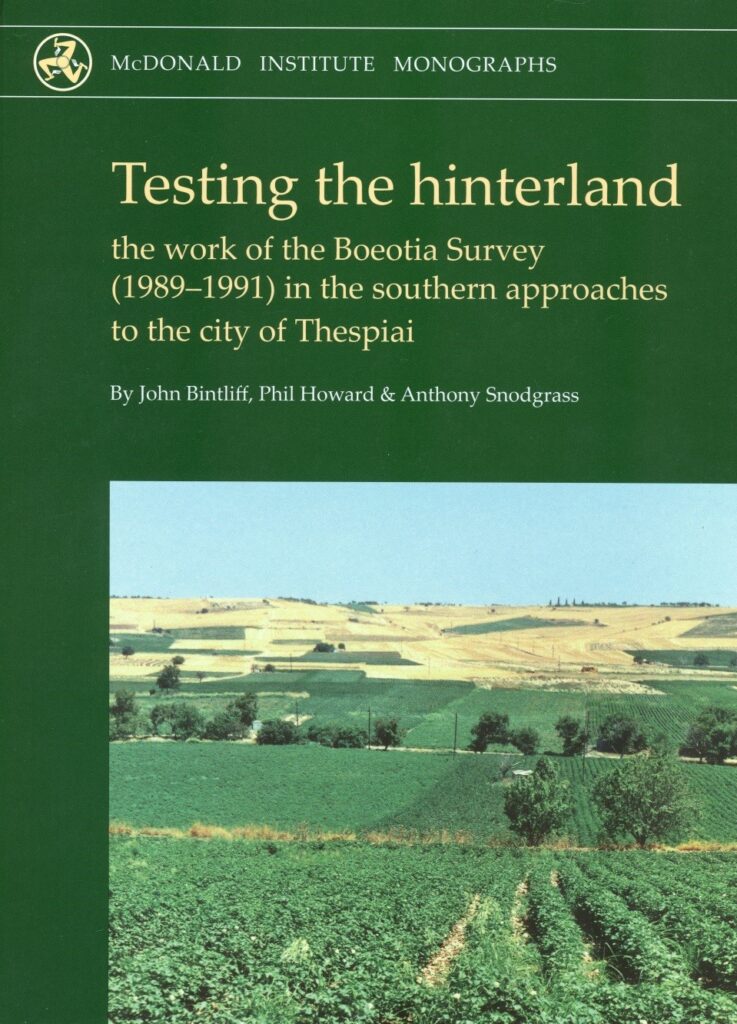
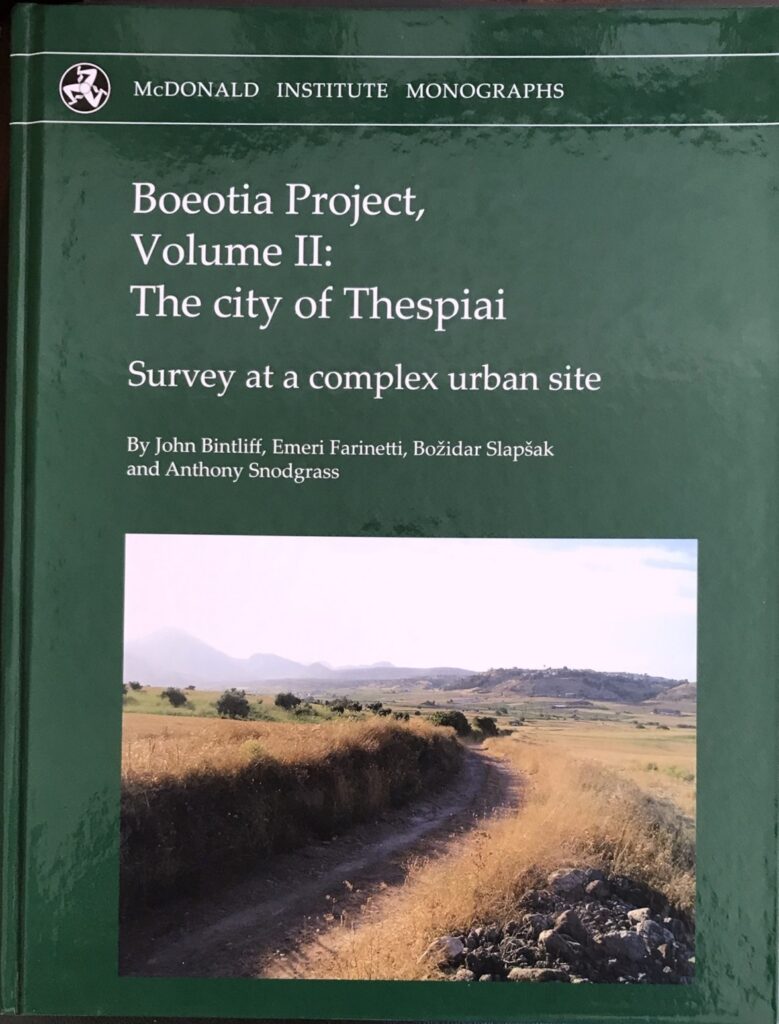
The wider significance of our results to this point led to a series of papers discussing the development of the city-states of Boeotia and their long-term development from the Early Iron Age through to Late Roman times (in Greece ca 400-650 AD).
Bintliff, J. L. and A. M. Snodgrass (1985). The development of settlement in South-West Boeotia. La Béotie Antique. G. Argoud and P. Roesch. Paris, CNRS: 49-70.
Bintliff, J. L. and A. M. Snodgrass (1988). The end of the Roman countryside: A view from the East. First Millennium Papers:Western Europe in the First Millennium AD. R.F.J.Jones, J.H.F.Bloemers, S.L.Dyson and M.Biddle. Oxford, British Archaeological Reports: 175-217.
Bintliff, J. L. and A. M. Snodgrass (1989). From polis to chorion in South-West Boeotia. Boitika. Vortraege vom 5. Internat. Bootien-Kolloquium. H.Beister and J.Buckler. Munich, Editio Maris: 285-299.
In order to obtain insight into whether our results for the settlement trajectories from Southwest Boeotia were similar to those in other districts of Boeotia, in 1989 a new area of survey was opened up in the north-eastern borderlands of the region, with an urban and rural survey in the territory of ancient Hyettos city. Preliminary reports were published and the final monograph publication of town and country is currently in press.
Bintliff, J. L., E. Farinetti and A. Snodgrass, Eds. (Forthcoming). Boeotia Project Volume 3. The Greek City State on a Small Scale. Hyettos in Boeotia and its Territory. Cambridge, McDonald Institute, Cambridge University.
To carry further our intra-regional comparisons, in 2000 a new town and country survey was begun in the far Southeast of the region, at and around the ancient city of Tanagra, where previously Duane Roller had carried out architectural and epigraphical study of the urban site. This part of the project was now a collaboration between the University of Leiden and Ljublana University, and was directed by John Bintliff and Bozidar Slapsak. Preliminary results have been published, including a remarkably detailed map of the Roman town achieved by Branko Music and Bozidar Slapsak. Annual reports on this work appeared in the Journal of the Netherlands Institute in Athens, Pharos, beginning with the first season in 2000.
Bintliff, J. L., E. Farinetti, et al. (2001). “The Tanagra Survey. Report on the 2000 season.” Pharos. Journal of the Netherlands Institute in Athens8: 93-127.
Bintliff, J. L., N. Evelpidou, et al. (2002). “The Leiden Ancient Cities of Boeotia Project: Preliminary Report on the 2001 season.” Pharos. Journal of the Netherlands Institute in Athens 9: 33-74.
Bintliff, J. et al. (2004). “The Leiden-Ljubljana Tanagra Project: the 2003 season.” Pharos. Journal of the Netherlands Institute in Athens 11: 35-43.
Bintliff, J. L. (2006). “The Leiden University Ancient Cities of Boeotia Project: 2005 season at Tanagra.” Pharos. Journal of the Netherlands Institute in Athens 13: 29-38.
An overview of the work at Tanagra also appeared as:
Bintliff, J. L., E. Farinetti, K. Sbonias, k. Sarri, V. Stissi, J. Poblome, A. Ceulemans, K. D. Craen, A. Vionis, B. Music, D. Kramberger and B. Slapsak (2008). “The Tanagra project: investigations at an ancient city and its countryside (2000-2002).” Bulletin de Correspondence Hellènique 2004-5: 541-606.
Bintliff, J. and B. Slapsak (2010). Tanagra. A Survey of the City. Tanagras. Figurines for Life and Eternity. V. Jeammet. Paris, The Louvre: 30-31.
The new co-director for this subproject, Bozidar Slapsak (Ljubljana University), brought an expert team in geophysical prospection, which achieved spectacular city plans from Tanagra.
Music, B., D. Kramberger, et al. (2008). “Geophysical and architectural survey.” Bulletin de Correspondence Hellènique 2004-5: 579-582.
Bintliff, J. L. and B. Slapsak (2007). Tanagra: la ville et la campagne environnante à la lumière des nouvelles méthodes de prospection, par les universités de Leyde et de Ljubljana. Tanagras. De l’objet de collection à l’objet archéologique. V. Jeammet. Paris, Musee Du Louvre Editions: 101-115)
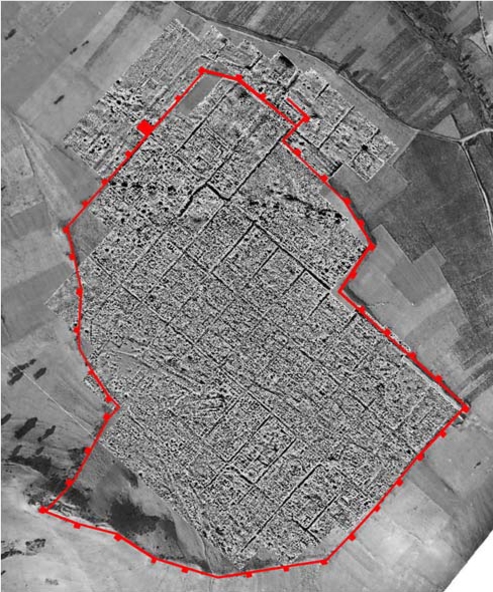
In this phase Emeri Farinetti (currently Roma Tre University), combined her work as GIS specialist for the Project in the Tanagra phase of fieldwork, with updating for her published doctoral thesis the Fossey gazetteer of sites in the entire province, where she applied GIS analysis to the resultant period-by-period distributions. Bart Noordervliet and Janneke van Zwienen (Leiden) took over fieldwork GIS work for the Koroneia period and subsequent restudy years. Currently GIS work is shared between Emeri Farinetti and Phil Howard.
Farinetti, E. (2011). Boeotian Landscapes: A GIS-based study for the reconstruction and interpretation of the archaeological datasets of ancient Boeotia. Oxford, British Archaeological Reports S2195).
With the completion of the urban and rural surface survey at Tanagra and in its hinterland, a final district was opened up for comparison, with survey at the ancient city of Koroneia, in Central Boeotia, beginning in 2006. This was completed by 2012. Annual reports on the preliminary results appeared once more in Pharos, and since then in the online journal Teiresias.
Bintliff, J. L. (2006). “The Leiden University Ancient Cities of Boeotia Project: 2005 season at Tanagra.” Pharos. Journal of the Netherlands Institute in Athens 13: 29-38.
Bintliff, J. and B. Slapsak (2007). “The Leiden-Ljubljana Ancient Cities of Boeotia Project. Season 2006.” Pharos. Journal of the Netherlands Institute in Athens 14: 15-27.
Bintliff, J. L., B. Slapsak, et al. (2009 (2007)). “The Leiden-Ljubljana Ancient Cities of Boeotia Project. Summer 2007-Spring 2008.” Pharos. Journal of the Netherlands Institute in Athens 15: 18-42.
Bintliff, J., B. Slapšak, et al. (2010). “The Leiden-Ljubljana Ancient cities of Boeotia Project 2008 season.” Pharos 16: 31-60.
Bintliff, J. L., B. Slapsak, et al. (2012). “The Leiden-Ljubljana Ancient Cities of Boeotia Project 2009 seasons.” Pharos 17: 1-63.
Bintliff, J. L., B. Noordervliet, et al. (2014). “The Leiden-Ljubljana Ancient Cities of Boeotia Project, 2010-2012 seasons.” Pharos 19: 1-34.
Bintliff, J., Noordervliet, B. et al. (2015). “The Leiden Ancient Cities of Boeotia Project: the 2013-2014 seasons.” Pharos 21 (2): 1-15.
Bintliff, J. L. (2016). “Leiden Ancient Cities of Boeotia. The 2015-Spring 2016 seasons.” Pharos 22:2: 1-15.
Bintliff, J. L. (2016). “Leiden Ancient Cities of Boeotia Project: the April and August 2016 seasons.” Teiresias 46.2: 1-10.
The city of Koroneia could be completely surveyed in open landscape and its classification into potential urban zoning encouraged us to commission a PhD study in which a Virtual Reality version of its Hellenistic florescence was created. This study was completed by Chiara Piccoli (currently at Amsterdam University) (next Figure), and she is also working with Emeri Farinetti on a similar reconstruction for ancient Haliartos, where an excellent clear city plan was revealed by geophysics and through Emeri’s surface mapping of streets and houses with her students from Roma Tre University.

It became clear as we were completing our urban survey at Koroneia in 2012, that additional insights could be obtained, similar to those shown for the city of Tanagra, at our other city survey sites, with the largescale deployment of modern geophysics. Given that one partner in the original university partnership, Bradford University, was a pioneering centre in this field, we had already made extensive use of this form of remote sensing on our rural sites, particularly with the PhD research of Chris Gaffney (1990). Since this work in the 1980s, geophysics had become faster and developed a range of techniques for different soil conditions. We commissioned test surveys by Cornelius Meyer and his team at Eastern Atlas, Berlin, at Koroneia, to locate city wall lines and aspects of the central market area or Agora, and they reopened geophysical survey at Tanagra to define the expanded boundaries of the town. We also commissioned on a much larger scale from Apostolos Sarris and his team from FORTH, Crete, a geophysical survey over much of the Lower Town of ancient Hyettos and over that of ancient Haliartos. These resulted in preliminary studies, which were summarized in the journal Pharos and will appear in full detail in the forthcoming monographs devoted to each of these cities. Summary details of the results from these surveys have appeared in our more recent papers (see later below).
Gaffney, C. G. (1990). The Schlumberger Array in Geophysical Prospection for Archaeology. PhD thesis, Bradford University.
Meyer, C. and D. Pilz (2014). Magnetic survey in Koroneia. The Ancient Cities of Boeotia Project (Boeotia, Greece). Berlin, Eastern Atlas GmbH & Co. KG Geophysical Prospection, Unpublished Report.
Meyer, C., D. Pilz, R. Kniess and L. Goossens (2016). Magnetic survey in Koroneia. The Ancient Cities of Boeotia Project (Boeotia, Greece). Field campaign 2015. Berlin, Eastern Atlas GmbH & Co. KG, Unpublished Report.
Meyer, C., R. Kniess and L. Goossens (2017). Geophysical Prospection in the ancient city of Tanagra (Boeotia, Central Greece). Berlin, Eastern Atlas GmbH, Unpublished Report.
Sarris, A. (2015). Technical Report: Geophysical Investigations at Hyettos, Boeotia. Phase III: 2015. Rethymnon, FORTH, Unpublished Report.
Sarris, A. (2016). Technical Report: Exploring the Urban Fabric of Haliartos, Boeotia, through Remote Sensing Techniques. 2016. Rethymnon, FORTH, Unpublished Report.
From the 1990’s onwards a new subproject was focussed on deserted medieval and post-medieval villages in Boeotia. Several had already been visited and collected from in earlier seasons, especially in 1983, but in 1993-1994 accumulating knowledge of the relevant evidence stimulated a more intense focus on such sites across the whole of the province of Boeotia. Firstly the Project had achieved a growing understanding of the ceramics of these eras, notably through the fortune of having our Classical to Modern ceramics dated initially by John Hayes. Secondly came a deeper understanding of the significance of Frankish-Crusader era towers as markers of rural villages, particularly through the participation of Peter Lock of York University. His research with us led to a major article (Lock 1986), a significant conference volume (Lock and Sanders (1996) and a new textbook for the period (Lock 1995).Thirdly came the availability of the Ottoman tax records for the province, through participation in the Project by Machiel Kiel (Utrecht/ Bonn Universities). We were able to locate some 75% of the taxed villages mentioned in the Ottoman archives between the 15th and 17th centuries AD (see following map below) (cf. Kiel 1997, Bintliff1995).
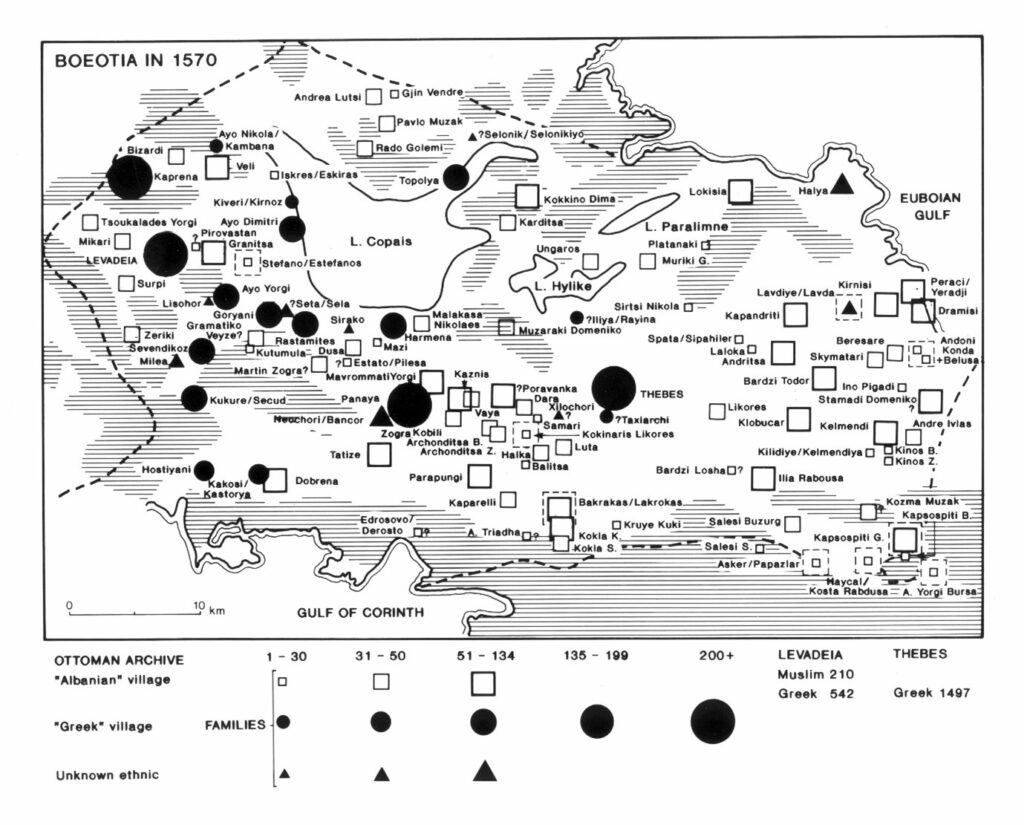
Some of the deserted villages retained house ruins, which encouraged us to undertake a related on the history of domestic housing in Boeotia, not least since traditional houses were being destroyed in favour of international-style concrete replacements at an alarming rate. Recording of houses at deserted villages, and existing as ruins or reused as sheds in existing villages was later complemented by the study of urban houses at modern Livadheia city. A pioneer paper appeared with the work of Nancy Stedman (see following illustration (Stedman, N. 1996, based on her fieldwork in 1983). The study of Livadheia town appeared a few years later (Bintliff, J., F. Aalen, et al. 1999).
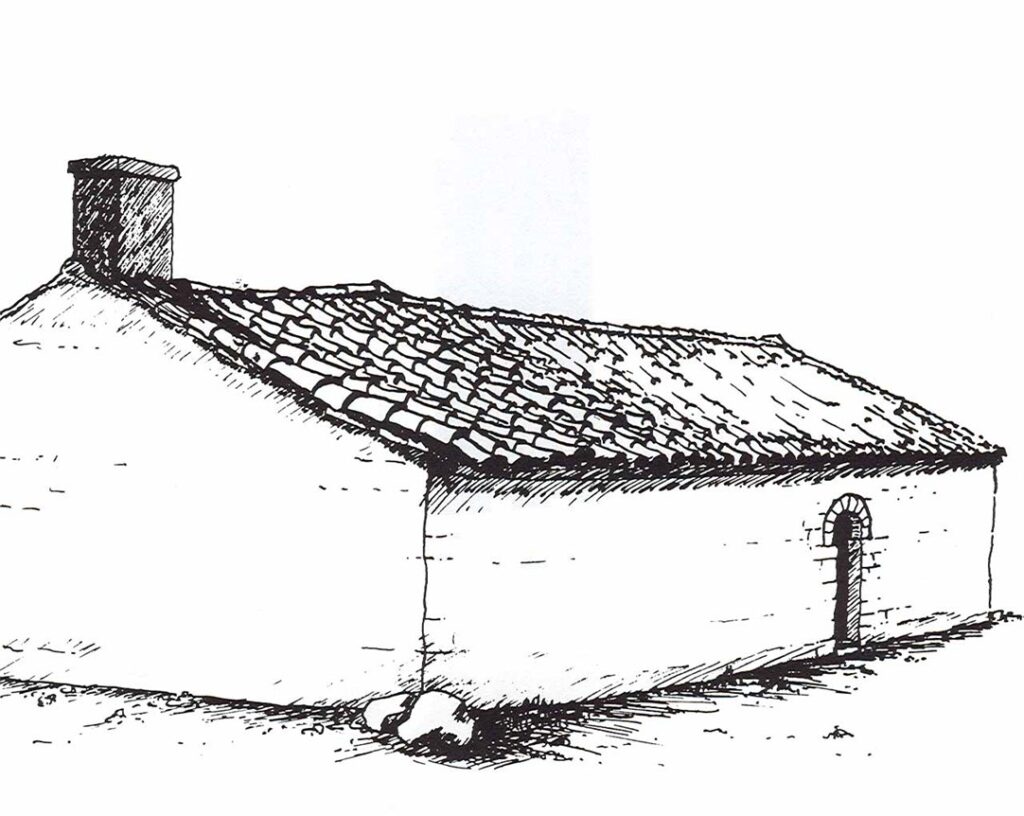
These diverse studies of domestic housing culminated in the doctoral thesis of Lef Sigalos, which linked the Boeotian development with the published evidence available for the rest of Greece (Sigalos, 2004).
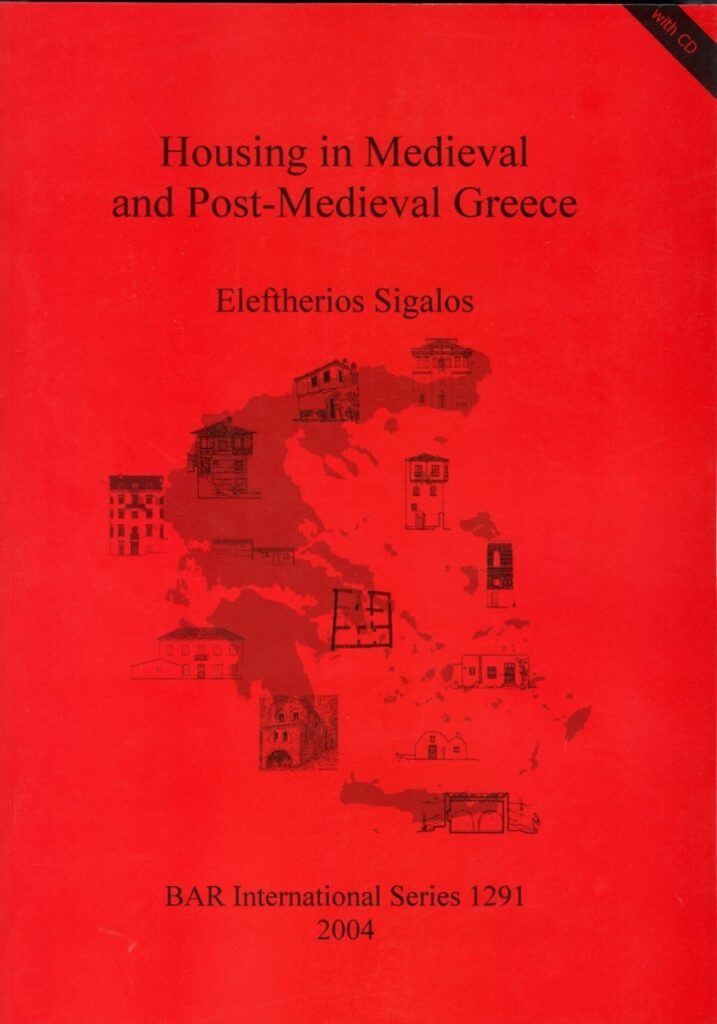
Lock, P. (1986). “The Frankish towers of Central Greece.” Annual of the British School at Athens 81: 101-123.
Lock, P. and G. D. R. Sanders, Eds. (1996). The Archaeology of Medieval Greece. Oxford, Oxbow.
Lock, P. (1995). The Franks in the Aegean 1204-1500. London, Longman.
Kiel, M. (1997). The rise and decline of Turkish Boeotia, 15th-19th century. Recent Developments in the History and Archaeology of Central Greece. J.L.Bintliff. Oxford, Tempus Reparatum: 315-358.
Bintliff, J. L. (1995). The Two Transitions: Current Research on the Origins of the Traditional Village in Central Greece. Europe Between Late Antiquity and the Middle Ages. Recent Archaeological and Historical Research in Western and Southern Europe. J. L. Bintliff and H. Hamerow. Oxford, Tempus Reparatum. BAR International Series 617: 111-130.
Stedman, N. (1996). Land-use and settlement in post-medieval central Greece: An interim discussion. The Archaeology of Medieval Greece. P. Lock and G. D. R. Sanders. Oxford, Oxbow: 179-192).
Bintliff, J., F. Aalen, et al. (1999). The traditional vernacular architecture of Livadhia. Livadhia: Past, Present and Future, Proceedings of the 1997 Conference. Anon. Livadhia, Municipality of Livadhia: 85-99).
Sigalos, E. (2004). Housing in Medieval and Post-Medieval Greece. Oxford, British Archaeological Reports Int. Ser. 1291).
Since active survey fieldwork ceased in 2014, subsequent years have focussed on preparing the many subprojects for monograph publication. Since the original dating of the ceramic finds central to our work began in 1980’s, it has been necessary to redate this material in the light of new knowledge, a task carried out to the current period by Kalliope Sarri (Prehistory), Vladimir Stissi and Anna Meens (Early Iron Age to Hellenistic), Philip Bes (Roman to Late Roman), and Athanasios Vionis (Medieval to Modern). Revisiting of our landscapes and sites continues also, to check on site size and preservation, and undertake topographical and land use studies. Drone photography to reveal site locational considerations has been pioneered for our Project by Lieve Donnellan (next illustration). Geophysical research at our ancient city sites will be carried out to answer outstanding questions on their changing occupation. In parallel social anthropological studies of local communities are being carried out by Hamish Forbes. These recent years are reported in annual articles in Teiresias.
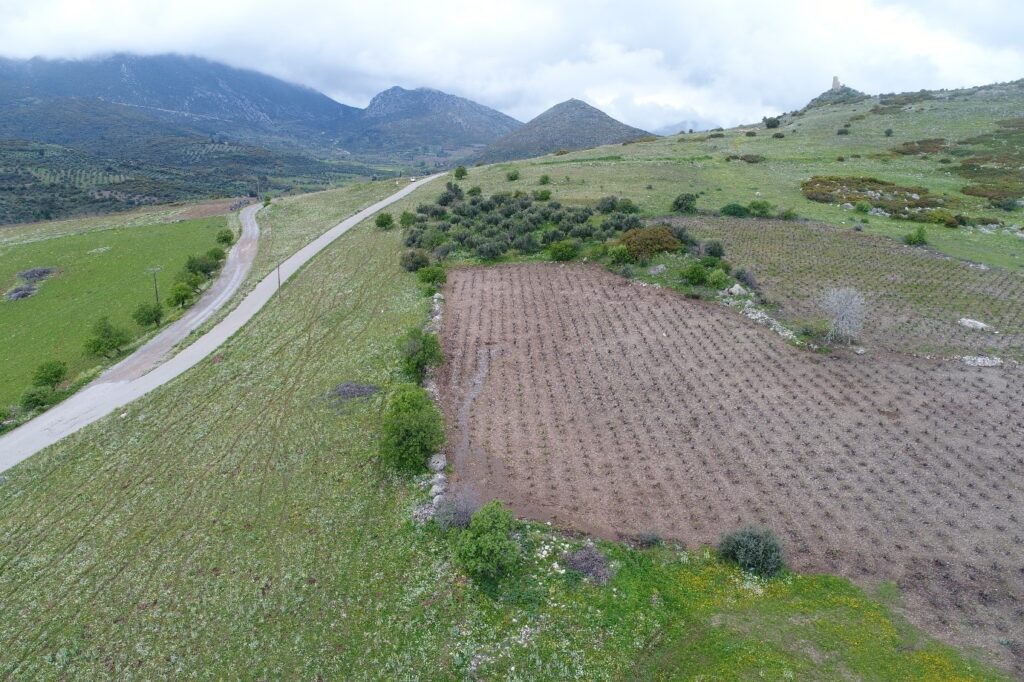
Bintliff, J. L. (2017). “The Leiden Ancient Cities of Boeotia Project, 2017 Season.” Teiresias 47(2): 3-7.
Bintliff, J. L. and A. M. Snodgrass (2018). “Report on the Research conducted in 2018 on the Boeotia regional project.” Teiresias 48.2: 3-7.
Bintliff, J. (2019). “Report of the Research Carried out by the Boeotia Project in 2019.” Teiresias 49.2: 2-5.
Bintliff, J.L. (2022). “Report of the Research Carried out by the Boeotia Project in 2020-2021”. Teiresias 2021-2, 2-4.
The current and final phase of the Boeotia is the publication of a monograph series from the McDonald Institute, Cambridge University, presenting each of our main district surveys in turn. So far two volumes have been published.
I: the countryside south of ancient Thespiai, II. the city of Thespiai. The third is in press – III: Hyettos and its Countryside, and in 2023 the fourth is being collated – IV: Askra and the Valley of the Muses. 2024 will see our focus move to preparing the fifth volume – V. Haliartos and its Countryside. Future volumes will present the remaining rural areas surveyed in the first phases of the Project, followed by the most recent urban and rural survey volumes for Tanagra and Koroneia, and then a special volume of Deserted Medieval and Post-Medieval Villages and the Traditional Architecture of the Town of Livadheia.
At the same time we are publishing articles, book chapters and monographs, which present aspects of the Boeotia results in a broader historical, archaeological and methodological framework. Recent examples follow:
Vionis, A. K. (2001). “Post-Roman pottery unearthed: Medieval ceramics and pottery research in Greece.” Medieval Ceramics 25: 84-98.
Vionis, A. (2006). The archaeology of Ottoman villages in central Greece: ceramics, housing and everyday life in post-medieval Boeotia. Studies in Honour of Hayat Erkanal: Cultural Reflections. A. Erkanal-Oktu, E. Ozgen, S. Gunel and a. Et. Istanbul, Homer Kitabevi: 784-800.
Vionis, A. (2008). “Current archaeological research on settlement and provincial life in the Byzantine and Ottoman Aegean.” Medieval Settlement Research 23: 28-41.
Bintliff, J. L. (2011). Problems of chronology and function in survey assemblages: the 1999 Hidden Landscape debate reviewed. Hidden Landscapes of Mediterranean Europe. M. van Leusen, G. Pizziolo and L. Sarti. Oxford, BAR International Series 2320: xv-xix.
Bes, P., J. Poblome, D. Malfitana and J. Bintliff (2011). Late Roman tablewares from the survey at ancient Tanagra. When did Antiquity End? R. Attou. Oxford, BAR International Series 2268: 129-136.
Bintliff, J. L. (2012). The Complete Archaeology of Greece, from Hunter-Gatherers to the Twentieth Century AD. Oxford-New York, Blackwell-Wiley.
Bintliff, J. L. (2012). GIS and the source-critical analysis of intensive survey data on- and off-site. Tecnologias de Informacion Geografica y Analysis Arqueologico del Territorio. V. Mayoral Herrera and S. Celestino Perez. Merida, Instituto de Arqueologia: 43-59.
Bintliff, J. L. (2012). Contemporary issues in surveying complex urban sites in the Mediterranean region: the example of the city of Thespiai (Boeotia, Central Greece). Urban Landscape Survey in Italy and the Mediterranean. F. Vermeulen, G.-J. Burgers, S. Keay and C. Corsi. Oxford, Oxbow: 44-52.
Bintliff, J. (2013). The Hellenistic to Roman Mediterranean: A proto-capitalist revolution? Economic Archaeology. T. Kerig and A. Zimmermann. Bonn, Rudolf Habelt: 285-292.
Bintliff, J. (2013). Poverty and resistance in the material culture of Early Modern rural households in the Aegean. Pottery and Social Dynamics in the Mediterranean and Beyond in Medieval and Post-Medieval Times. J. L. Bintliff and M. Caroscio. Oxford, British Archaeological Reports: 41-46.
Bintliff, J. L. (2013). Public versus professional perceptions of an invisible heritage: A Greek case study. Appropriate Narratives. Archaeologists, Publics and Stories. E. Niklasson and T. Meier. Budapest, Archaeolingua: 237-247.
Bintliff, J. L. (2013). Central Greece in late antiquity: the evidence from the Boeotia Project. Field Methods and Post-Excavation Techniques in Late Antique Archaeology. L. Lavan and M. Mulryan. Leiden, Brill: 189-203.
Bintliff, J. L. (2013). The contribution of regional surface survey to Byzantine landscape history in Greece. Exempli Gratia. Sagalassos, Marc Waelkens and Interdisciplinary Archaeology. J. Poblome. Leuven, Leuven University Press: 127-139.
Bintliff, J. L. (2013). Survey Archaeology in the Greek Aegean World. Encyclopedia of Global Archaeology. C. Smith. New York, Springer Science+Business Media: 1-8.
Bintliff, J. L. (2014). Ch. 11: Intra-site artefact surveys. Good Practice in Archaeological Diagnostics. C. Corsi and e. al. Berlin, Springer Verlag: 193-207.
Bintliff, J. (2015). Recent developments in the Archaeology of Ottoman to Early Modern Greece. Recent Developments in the Archaeology of Greece. J. Bintliff. Leuven, Pharos Supplement: 347-369.
Bintliff, J. L. (2016). The First Thirty-Six Years of the Boeotia Project, Central Greece. The Archaeology of Greece and Rome. Studies in Honour of Anthony Snodgrass. J. L. Bintliff and N. K. Rutter. Edinburgh, Edinburgh University Press: 447-457.
Snodgrass, A. (2016). Thespiai and the Fourth Century BC climax in Boiotia. Boeotia in the Fourth Century BC. S. D. Garland. Philadelphia: 9-31.
Vionis, A. (2016). “A boom-bust cycle in Ottoman Greece and the ceramic legacy of two Boeotian villages.” Journal of Greek Archaeology 1: 353-384.
Bintliff, J. (2017). Aspects of settlement change in late Antiquity from regional survey evidence. New Cities in Late Antiquity. Documents and Archaeology. A. Rizos. Turnhout, Brepols: 13-17.
Bintliff, J. L. (2017). Regional impact of the Ottoman empire in Greece: archaeological perspectives. Imperial Lineages and Legacies in the Eastern Mediterranean. R. Murphey. London, Routledge: 159-164.
Bintliff, J. L. (2017). Long-term developments in southern mainland settlement systems from Early Helladic to Late Helladic times as seen through the lens of regional survey. Social Change in Aegean Prehistory. C. Wiersma and S. Voutsaki. Oxford, Oxbow Books: 159-167.
Vionis, A. (2017). “Understanding Settlements in Byzantine Greece New Data and Approaches for Boeotia, Sixth to Thirteenth Century.” Dumbarton Oaks Papers 71(127-173).
Bintliff, j. and K. Sarri (2018). Demographic transitions from the Earlier Neolithic stages until the first Early Bronze Age settlements in the plains and hill-country of Boeotia, Greece. Communities in Transition. The Circum-Aegean Area during the 5th and the 4th millennia BC. Oxford, Oxbow Books. S. Dietz, F. Mavridis and e. al. Oxford, Oxbow Books: 249-259.
Bintliff, J. L. (2018). Rural Sicily and Achaia under the impact of Rome. Römisches Sizilien: Stadt und Land zwischen Monumentalisierung und Ökonomie, Krise und Entwicklung – Göttingen, Georg-August-Universität, Archäologisches Institut, 25. – 27. November 2017. J. Bergemann. Gottingen: 409-420.
Bintliff, J. L. (2018). The development of surface survey in the Mediterranean: A brief history. Funde in der Landschaft. C. Wohlfahrt and C. Keller. Bonn, LVR-Amtes fur Bodendenkmalpflege im Rheinland: 151-158.
Snodgrass, A. (2018). “Recovering a lost city. Tracing the rise and fall of Thespiai.” Current World Archaeology 89: 32-36.
Bintliff, J. (2019). The transformation of Medieval and Post-Medieval archaeology in Greece. Mediterranean Landscapes in Post Antiquity. New frontiers and new perspectives. S. Gelichi and L. Olmo-Enciso. Oxford, Archaeopress. 1-6.
Bintliff, J. (2019). City-archaeology in Boeotia: continuity and discontinuity, localism and globalisation. La Béotie de l’archaïsme à l’époque romaine. Frontières, territoires, paysages. T. Lucas, C. Muller and A. C. Oddon-Panissie. Paris, Editions de Boccard: 121-133.
Attema, P., J. Bintliff and M. van Leusen (2020). “A guide to good practice in Mediterranean surface survey projects.” The Journal of Greek Archaeology 5: 1-62.
Bintliff, J. (2020). “Medieval landscapes of Greece and Turkey: a post-colloquium commentary.” Journal of Greek Archaeology 5: 535–541.
Bintliff, J. L. (2020). Chapter 1.1 Natural and human ecology: geography, climate, resources and demography. A Companion to the Archaeology of Early Greece and the Mediterranean. A. Kotsonas and I. Lemos. Oxford-New York, Wiley-Blackwell. 1: 3-32.
Bintliff, J. L. (2020). Variations on a Theme of Empire: Comparing Mediterranean Imperial Systems in the Longue Durée. Political and Economic Interaction on the Edge of Early Empires. D. A. Warburton. Berlin, eTopoi, Special Volume 7: 22–32.
Vionis, A. (2020). “Bridging the Early Medieval ‘ceramic gap’ in the Aegean and the Eastern Mediterranean (7th-9th c.): local and global phenomena.” Herom 9: 291-326.
Vionis, A. K. (2020). “Landscape approaches to the evolution of the Byzantine/Medieval village-community in Greece.” Journal of Greek Archaeology 5: 468–494.
Bintliff, J. (2021) “Epilogue: The survival of cities after military devastation: comparing the Classical Greek and Roman experience”, in S. Fachard and E. Harris (eds.) The Destruction of Cities in the Ancient Greek World, Cambridge: Cambridge University Press, 340-354.
Bintliff, J., P. Degryse and J. van Zwienen (2022). “The long term programme of trace metal analysis at the ancient city of Hyettos.” Journal of Archaeological Science: Reports 43: 103432.
Bintliff, J. (2023). “Survey Archaeology in the Greek Aegean World.” Encyclopedia of Global Archaeology.
Bintliff, J. (2023). “Agricultural intensification and the evidence from offsite survey archaeology.” Journal of World Prehistory https://doi.org/10.1007/s10963-023-09176-4.
